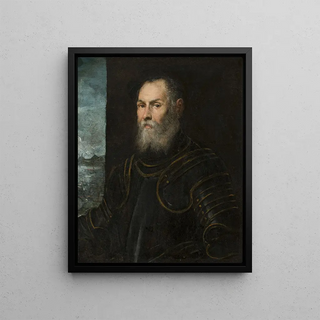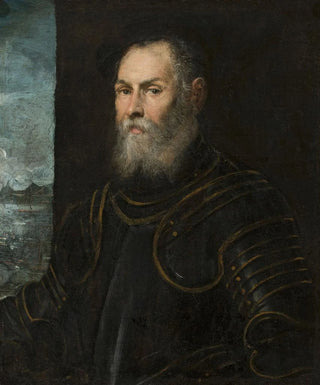Art print | Portrait of a Venetian admiral - Jacopo Tintoretto


View from behind

Frame (optional)
Venetian Admiral Portrait - Jacopo Tintoretto – Captivating Introduction
The "Venetian Admiral Portrait" by Jacopo Tintoretto embodies the very essence of power and authority through the lens of the Venetian Renaissance. This artwork, created in the 16th century, immerses us in a universe where the sea, a symbol of wealth and commerce, intertwines with military grandeur. The admiral, depicted with undeniable presence, seems almost to emerge from the canvas, captivating the viewer with his determined gaze and majestic posture. The atmosphere emanating from this piece is both solemn and dynamic, reflecting the tensions and triumphs of an era when Venice was at its peak.
Style and uniqueness of the work
Tintoretto, an undisputed master of chiaroscuro, uses light and shadow to emphasize the features of his subject. The sfumato technique, which creates smooth transitions between colors, gives the artwork a striking depth. The choice of colors, ranging from dark tones to vibrant shades, highlights the richness of the admiral's attire, while accentuating his face marked by time and experience. Every detail, from the embroidered fabric of his coat to the reflections of light on his armor, is carefully studied, demonstrating the artist's technical expertise. This portrait is not just a simple representation; it tells a story, that of a man serving the Republic of Venice, ready to defend his territory and honor.
The artist and his influence
Jacopo Tintoretto, born in 1518 in Venice, is one of the major figures of Renaissance painting. His bold style and ability to capture movement and emotion have influenced many artists, both contemporaries and successors. Tintoretto managed to blend Venetian tradition with an innovative approach, incorporating dramatic elements that make his works captivating visual narratives. His legacy endures through the centuries, inspiring generations of artists to explore the limits of painting. His use of perspective and dynamic composition paved the way for innovations in Western art, making him a

Matte finish

View from behind

Frame (optional)
Venetian Admiral Portrait - Jacopo Tintoretto – Captivating Introduction
The "Venetian Admiral Portrait" by Jacopo Tintoretto embodies the very essence of power and authority through the lens of the Venetian Renaissance. This artwork, created in the 16th century, immerses us in a universe where the sea, a symbol of wealth and commerce, intertwines with military grandeur. The admiral, depicted with undeniable presence, seems almost to emerge from the canvas, captivating the viewer with his determined gaze and majestic posture. The atmosphere emanating from this piece is both solemn and dynamic, reflecting the tensions and triumphs of an era when Venice was at its peak.
Style and uniqueness of the work
Tintoretto, an undisputed master of chiaroscuro, uses light and shadow to emphasize the features of his subject. The sfumato technique, which creates smooth transitions between colors, gives the artwork a striking depth. The choice of colors, ranging from dark tones to vibrant shades, highlights the richness of the admiral's attire, while accentuating his face marked by time and experience. Every detail, from the embroidered fabric of his coat to the reflections of light on his armor, is carefully studied, demonstrating the artist's technical expertise. This portrait is not just a simple representation; it tells a story, that of a man serving the Republic of Venice, ready to defend his territory and honor.
The artist and his influence
Jacopo Tintoretto, born in 1518 in Venice, is one of the major figures of Renaissance painting. His bold style and ability to capture movement and emotion have influenced many artists, both contemporaries and successors. Tintoretto managed to blend Venetian tradition with an innovative approach, incorporating dramatic elements that make his works captivating visual narratives. His legacy endures through the centuries, inspiring generations of artists to explore the limits of painting. His use of perspective and dynamic composition paved the way for innovations in Western art, making him a






